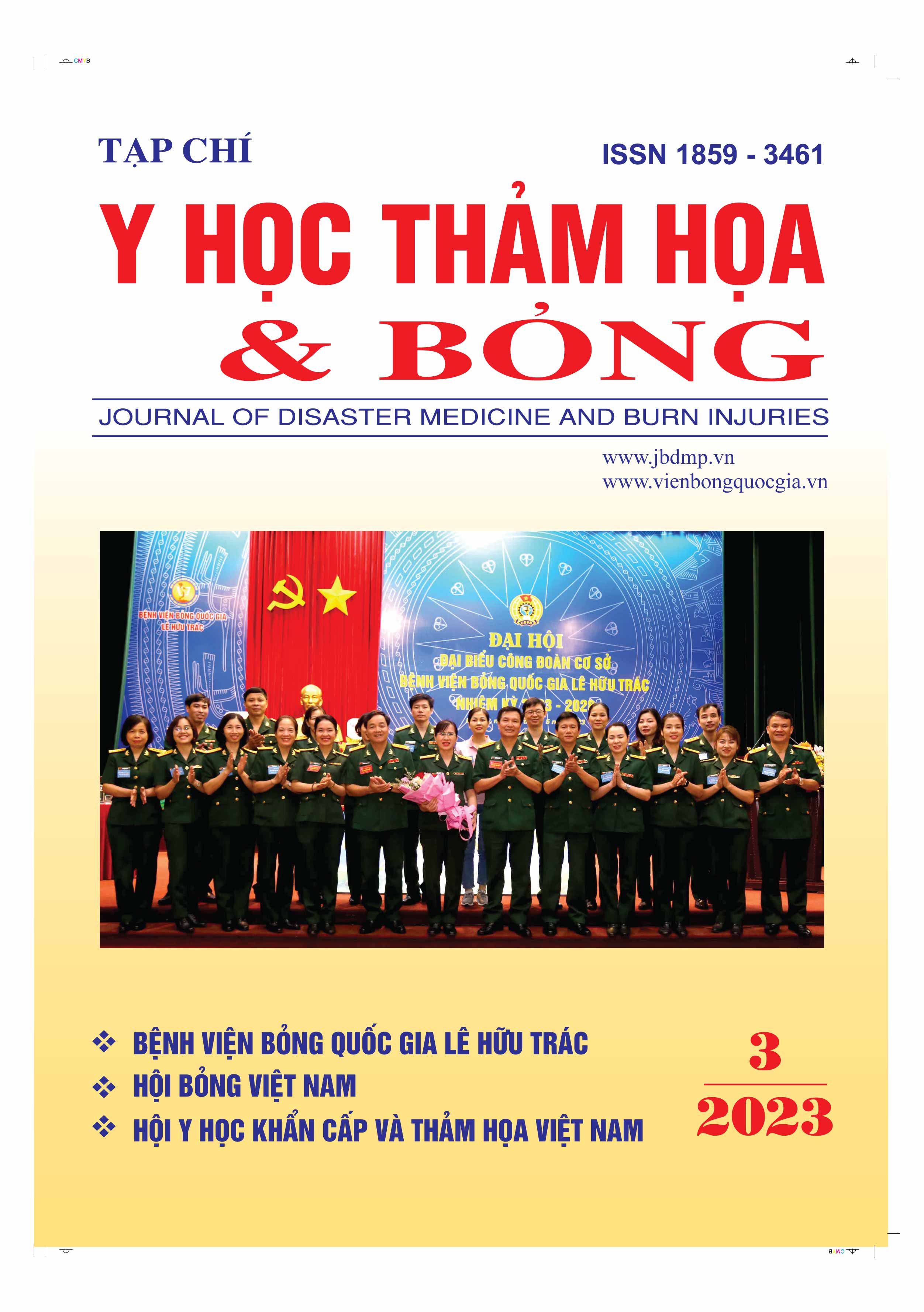Evaluate the clinical therapeutic effect of Hemingel HOCl in chronic wounds
Main Article Content
Abstract
The study to evaluate the clinical therapeutic effect of Hemingel (gel containing HOCl 0.02%) in chronic wounds; study subjects: 30 burn patients with slow-healing wounds, methods: prospective study, comparison before and after trial; systemic and local clinical assessment criteria. Result: Inflammation of the wound and purulent exudate is significantly reduced, the epithelialization of the margin is increased, the granulation tissue is more beautiful, the wound area is significantly narrowed, facilitating skin grafting. There were no allergic manifestations, systemic or local disorders related to the use of the drug.
Conclusion: Hemingel has anti-inflammatory and antibacterial effects; Facilitates chronic wound healing; safe patient use.
Article Details
Keywords
Chronic wound, HOCl gel, antibacterial, anti-inflammatory, wound healing
References
2. Han G, Ceilley R (2017); Chronic wound healing: a review of current management and treatments. Adv Ther 34(3): 599-610
3. Boersema GC, Smart H, Giaquinto-Cilliers MG, et al. (2021). Management of unhealable and maintenance wounds: a systematic integrative review and referral pathway. Adv Skin Wound Care 34(1): 11-22
4. Fridman and Dino RechSibbald RG, Elliott JA, Ayello EA, Somayaji R (2015). Optimizing the moisture management tightrope with wound bed preparation. Adv Skin Wound Care; 28(10): 466-76.
5. Woo KY, Krasner DL, Kennedy B., et al (2015); Palliative wound care management strategies for palliative patients and their circles of care. Adv Skin Wound Care 28(3): 130-40, quiz 140-2
6. Woo K, de Gouveia Santos VLC, Alam T (2018); Optimising quality of life for people with non-healing wounds. Wounds International 9(3): 6-14
7. Krister Järbrink, Gao Ni, Henrik Sönnergren, Artur Schmidtchen, Caroline Pang, Ram Bajpai, and Josip Ca (2016). “Prevalence and incidence of chronic wounds and related complications: a protocol for a systematic review”. Syst Rev. 2016; 5(1): 152
8. Zhao R, Liang H, Clarke E, et al (2016). Inflammation in chronic wounds. Int J Mol Sci 17(12): 2085
9. Armstrong DG, Bohn G, Glat P, et al. Expert recommendations for the use of hypochlorous solution: science and clinical application. Ostomy Wound Manage. 2015; 61: S2-S19.
10. Block MS, Rowan BG. Hypochlorous acid: a review. J Oral Maxillofac Surg. 2020; 78: 1461-1466.
11. Day A, Alkhalil A, Carney BC, Hoffman HN, Moffatt LT, Shupp JW. Disruption of biofilms and neutralization of bacteria using hypochlorous acid solution: an in vivo and in vitro evaluation. Adv Skin Wound Care. 2017; 30: 543- 551.
12. Dissemond J. Wound cleansing: benefits of hypochlorous acid. J Wound Care. 2020; 29(10): S4- S8.
13. Medina-Tamayo J, Sanchez-Miranda E, Balleza-Tapia H et al. Superoxidized solution inhibits IgE-antigen-induced degranulation and cytokine release in mast cells. Int Immunopharmacol. 2007; 7: 1013-1024.
14. Draelos Z. Evaluation of a gel formulation of hypochlorous acid and sodium hypochlorite to reduce pruritus in mild to moderate atopic dermatitis. Winter Clin. 2012; 103: 624-628.
15. Rafael Herruzo Ph.D., MD, Erika Fondo Alvarez MSc, Irene Herruzo Ph.D., Emma Santiso Casanova MSc, Synergistic effect of two formulations of hypochlorous acid in the treatment of 346 chronic ulcers; wound repair and regeneration; Volume31, Issue3; May/June 2023; Pages 401-409
16. Del Rosso JQ, Bhatia N. Status report on topical hypochlorous acid: clinical relevance of specific formulations, potential modes of action, and study outcomes. J Clin Aesthet Dermatol. 2018; 11: 36-39.
17. Sakarya S, Gunay N, Karakulak M et al. Hypochlorous acid: an ideal wound care agent with powerful microbicidal, antibiofilm, and wound healing potency. Wounds. 2014; 26: 342-350.
18. Gold MH, Andriessen A, Bhatia AC, et al. Topical stabilized hypochlorous acid: the future gold standard for wound care and scar management in dermatologic and plastic surgery procedures. J Cosmetic Dermatol. 2020; 19: 270-277.
19. National Pressure Ulcer Advisory Panel (2016), NPUAP Pressure Injury Stages, http://www.npuap.org/
20. Menke N.B., Ward K.R., Witten T.M., Bonchev D.G., Diegelmann R.F (2007). “Impaired wound healing”. Clin Dermatol. 2007, 25:19-25


